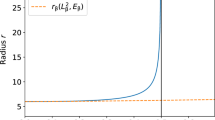Abstract
It has been shown that a rotating Black Hole (BH hereafter) immersed in a test background magnetic field, of initial strength \({{B}_{0}}\) and aligned parallel to the BH rotation axis, generates an induced electric field, which strength is proportional to the background magnetic field. We consider the configuration of crossed fields: \({\mathbf{B}} = B\hat {z}\) and \({\mathbf{E}} = E\hat {y}\). In this system, a huge number of \({{e}^{ + }}{{e}^{ - }}\) pairs can be emitted and start to be accelerated to high energies, by means of the induced electric field, and emit synchrotron photons. These photons interact with the magnetic field via the magnetic pair production process (MPP hereafter), \(\gamma + B \to {{e}^{ + }} + {{e}^{ - }}\). The motion of all these pairs around the magnetic field lines generates also an induced magnetic field oriented in the opposite direction to the background one. This implies a reduction of the background magnetic field. The purpose of this study is to show if this reduction occurs, which implies a decreases the MPP efficiency and, consequently, the enhancement of the probability for the synchrotron photons to escape from the region and be detected.




Similar content being viewed by others
Notes
All the following equations are written in a dimensionless way, normalized with these criteria: the temporal variables, as \(t\) and \(1{\text{/}}{{\omega }_{0}}\), becomes \(\tilde {t} = t{\text{/}}{{\tau }_{c}}\) and \({{\tilde {\omega }}_{0}} = {{\omega }_{0}}{{\tau }_{c}}\), with \({{\tau }_{c}}\) the Compton time \({{\tau }_{c}} = \hbar {\text{/}}m{{c}^{2}} = 1.29 \times {{10}^{{ - 21}}}\) s; the length becomes \((\tilde {x},\tilde {y},\tilde {z}) = \) \((x,y,z){\text{/}}{{-\!\!\!\!\lambda }_{c}}\), with \({{-\!\!\!\!\lambda }_{c}}\) the Compton length \({{-\!\!\!\!\lambda }_{c}} = \hbar {\text{/}}mc = \) 3.86 × 10–11 cm; we can normalize the magnetic field as \(\tilde {B} = B{\text{/}}{{B}_{{{\text{cr}}}}}\) and the electric field as \(\tilde {E} = E{\text{/}}{{E}_{{{\text{cr}}}}}\), where the critical electric/magnetic field \({{E}_{{{\text{cr}}}}} = {{B}_{{{\text{cr}}}}} = m_{e}^{2}{{c}^{3}}{\text{/}}e = 4.41 \times {{10}^{{13}}}\) Gauss. All the energies, as the photon energy \({{\varepsilon }_{\gamma }}\), are normalized with the electrons rest mass energy \({{m}_{e}}{{c}^{2}} = 0.511\) MeV.
All the numerical integrations stop when the Lorentz factor of the particle becomes equal to 1, namely when the particle loses all of its energy due the emission of radiation. We start the integrations at \({{t}_{0}} = \) 10–21 s and the previous condition is reached at \({{t}_{f}} \sim {{10}^{{ - 18}}}{-} {{10}^{{ - 15}}}\) s, depending on the specific initial conditions.
REFERENCES
A. M. Fedotov, N. B. Narozhny, G. Mourou, and G. Korn, Phys. Rev. Lett. 105, 080402 (2010); arXiv: 1004.5398.
R. Ruffini, J. A. Rueda, M. Muccino, Y. Aimuratov, L. M. Becerra, C. L. Bianco, M. Kovacević, R. Moradi, F. G. Oliveira, G. B. Pisani, et al., Astrophys. J. 832, 136 (2016).
J. D. Jackson, Classical Electrodynamics (Am. Assoc. Phys. Teachers, 1999).
S. R. Kelner, A. Y. Prosekin, and F. A. Aharonian, Astron. J. 149, 33 (2015); arXiv: 1501.04994.
J. K. Daugherty and I. Lerche, Astrophys. Space Sci. 38, 437 (1975).
S. Campion, PhD Thesis (Rome, Italy, 2021).
S. Campion, J. A. Rueda, R. Ruffini, S.-S. Xue, Physics Letters B 820, 136562 (2021).
Author information
Authors and Affiliations
Corresponding authors
Additional information
Paper presented at the Fourth Zeldovich meeting, an international conference in honor of Ya.B. Zeldovich held in Minsk, Belarus, on September 7–11, 2020. Published by the recommendation of the special editors: S.Ya. Kilin, R. Ruffini, and G.V. Vereshchagin.
Rights and permissions
About this article
Cite this article
Campion, S., Rueda, J.A., Xue, S.S. et al. On the Magnetic Field Screening in Strong Crossed Electromagnetic Fields. Astron. Rep. 65, 911–915 (2021). https://doi.org/10.1134/S1063772921100048
Received:
Revised:
Accepted:
Published:
Issue Date:
DOI: https://doi.org/10.1134/S1063772921100048




